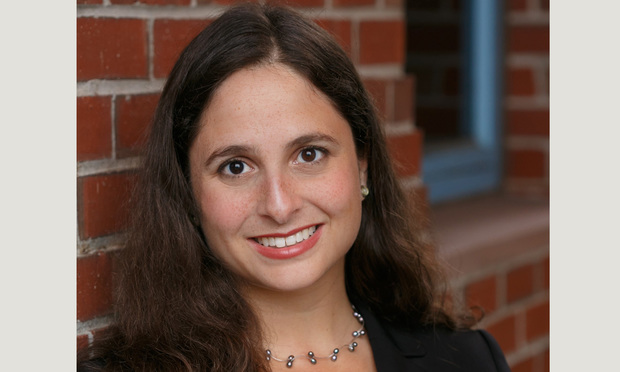Law Schools Shift Classes Online Amid COVID-19, but Can They Do It Successfully?
Fewer than 10 law schools have J.D. programs that are mostly online, and many law faculty have never taught a distance education class. Syracuse law professor Nina Kohn breaks down how law schools can effectively shift classes online amid in-person class cancellations due to the coronavirus.
March 10, 2020 at 04:10 PM
8 minute read
 Nina Kohn. Courtesy photo
Nina Kohn. Courtesy photo
Law schools in four states so far are canceling in-person classes and moving courses online amid the spread of the coronavirus. But legal education as a whole is less prepared for that shift than many other graduate programs due to its relatively slow adoption of online learning.
The American Bar Association in recent years has increased the number of credit hours schools are allowed to deliver online, but fewer than 10 law schools have J.D. programs that are mostly online and many law faculty have never taught a distance education class.
Syracuse University College of Law's JDInteractive program—launched in January 2019—was the second online program to be offered in the U.S., following Mitchell Hamline School of Law's hybrid program in 2015.
Professor Nina Kohn spearheaded the creation of JDInteractive and has taught many of its courses. Law.com talked with Kohn on Tuesday to discuss how law schools can quickly move to an online format, the mistakes law professors often make online, and whether the coronavirus will usher in a new era of online law teaching. Her answers have been edited for length and clarity.
Are you getting a lot of calls from professors and schools looking for advice on how to make the move online right now? I was beginning to get inquiries about that before coronavirus, and certainly now with coronavirus knocking on their doors, schools are scrambling to figure out: "What would it look like to move classes online?"
How do you think law schools, on the whole, are prepared to make this switch? Do they have the technology in place to make it happen? I think an important thing to remember in thinking about how to make the pivot from bricks and mortar to online is that online education isn't just one thing. There are two flavors of online class. There is the self-paced, asynchronous class. Then there is the live, real-time class. To move to the self-paced, asynchronous style in a way that is high quality takes a real investment of time, energy, and rethinking how you break down what is normally a live experience into self-paced components. It's easy to do self-paced badly. It's hard to do self-paced well in a manner that's interactive. That would be a difficult pivot for schools to make. But if we look at live online classes, that's a much easier pivot to make because you don't have to change how you're teaching. You just have to recognize that your classroom can be a virtual classroom. Readily accessible video conference software can be employed by law schools very rapidly to bring existing courses with existing faculty and existing students online quickly.
How do you make online classes interactive? How do you employ the Socratic method online? The key here is that you need to be able to see and hear all your students in real time. When I teach online in our JDInteractive program, in the live classes I'm using the Zoom platform. I can see and hear all my students. I can pick up on the body language. They can see each other's body language. I can cold call and have a Socratic discussion just the way I can in my residential classroom. In fact, it feels identical to me. And the student interactions are very similar as well. As a practical matter, schools looking to move online should prioritize software that allows them to have their faculty seeing all the students at once, as opposed to limiting the view to, say, six students.
Is that possible in a large lecture class with 100 students? There are two factors here: One is what platform are you using? With 100 you are pushing the envelope with any platform. But with a smaller class, some of the video conferencing software will allow you to see and hear everyone with the standard numbers in a law school class—40 or 50. The other issue is the hardware you are using. We expect faculty to have two screens running at all times. That means they have one screen up where they are just looking at students—ideally that's a large screen. And then you have a second screen for your PowerPoint, or polls, or teaching notes. We want faculty to have one screen just devoted to their students so they don't lose that organic experience that is seeing your students and responding to them. When I'm teaching live online, I ask my students who want to participate to raise their hand. I can see that just like I can see it in my classroom in Syracuse.
So if I'm a student in an online class, I shouldn't wear my pajamas because everyone can see me? Right. I wear a suit when I teach online. And I expect my students to come in professional wear as well.
Some of these law schools that are shifting online are coming up on final exams due to being on the quarter system. How do you give a final exam online? That is a potentially significant barrier. We, at Syracuse, don't give our final exams online. We do place-space proctoring. We want to make sure we have high levels of exam security, so we can be extraordinarily confident that each students' answer is their own. The online exam can be quite problematic, in terms of exam security. That said, there are techniques you can use. You can require everyone to take their exam in front of their webcam, and have that monitored in real time by one or more proctors. Or you can say, "Look, we're going to make this a timed exam, and we're going to say everything is available. There is no closed book. You can consult anyone you want." That gets rid of exam security issues because you aren't restricting what students can do. But at that point, you don't know to what extent the work is truly the student's own work. So if you are moving to an online exam, which is not what we do at Syracuse, a common best practice is to have students taking that on webcam and it being monitored live.
What are some of the most common mistakes you see when professors are translating legal education to the online format? One pitfall is not understanding the different modalities of online education, and assuming it has to be self-paced and not live. That's the biggest pitfall I see because then people think online education has to be something dramatically different than what they are doing in their classroom.
Another pitfall I see is faculty thinking online means not interactive. The good news is that our technology today is at a place where you can teach live online in a fully interactive manner. We need to make sure faculty aren't setting their expectations for themselves too low and thinking this is just an opportunity to simply lecture at students, as opposed to engaging students.
Another pitfall is not using the right technology. The good news is that the technology you need to use is very simple: You need a good web cam. You need a pair of headphones. And you need an extra monitor. Those are all small lifts. But without those small lifts, you can end up with a really unsatisfactory teaching and learning experience. And of course you need to make sure your faculty are teaching in a setting that is conducive to professional work. We always make sure our faculty are teaching from locations that are either a well-set up office on campus or a well-set up office off campus, so it's not distracting.
Do you think this shift online—forced by the coronavirus—will change the way legal educators view distance education? Will it speed its adoption? Absolutely. I think we're at an inflection point and the coronavirus will bring about a new understanding of the potential and value of online teaching. I hope that will allow people to understand how online teaching can be done in a high-quality way. The fear, of course, is that people will move into online education in a way that is not high quality and will learn some bad habits.
NOT FOR REPRINT
© 2025 ALM Global, LLC, All Rights Reserved. Request academic re-use from www.copyright.com. All other uses, submit a request to [email protected]. For more information visit Asset & Logo Licensing.
You Might Like
View All
The Week in Data Jan. 24: A Look at Legal Industry Trends by the Numbers


University of Chicago Accused of Evicting Student for Attending Gaza-Israel Protest
3 minute read
Sanctioned Penn Law Professor Amy Wax Sues University, Alleging Discrimination
5 minute readTrending Stories
- 1New York-Based Skadden Team Joins White & Case Group in Mexico City for Citigroup Demerger
- 2No Two Wildfires Alike: Lawyers Take Different Legal Strategies in California
- 3Poop-Themed Dog Toy OK as Parody, but Still Tarnished Jack Daniel’s Brand, Court Says
- 4Meet the New President of NY's Association of Trial Court Jurists
- 5Lawyers' Phones Are Ringing: What Should Employers Do If ICE Raids Their Business?
Who Got The Work
J. Brugh Lower of Gibbons has entered an appearance for industrial equipment supplier Devco Corporation in a pending trademark infringement lawsuit. The suit, accusing the defendant of selling knock-off Graco products, was filed Dec. 18 in New Jersey District Court by Rivkin Radler on behalf of Graco Inc. and Graco Minnesota. The case, assigned to U.S. District Judge Zahid N. Quraishi, is 3:24-cv-11294, Graco Inc. et al v. Devco Corporation.
Who Got The Work
Rebecca Maller-Stein and Kent A. Yalowitz of Arnold & Porter Kaye Scholer have entered their appearances for Hanaco Venture Capital and its executives, Lior Prosor and David Frankel, in a pending securities lawsuit. The action, filed on Dec. 24 in New York Southern District Court by Zell, Aron & Co. on behalf of Goldeneye Advisors, accuses the defendants of negligently and fraudulently managing the plaintiff's $1 million investment. The case, assigned to U.S. District Judge Vernon S. Broderick, is 1:24-cv-09918, Goldeneye Advisors, LLC v. Hanaco Venture Capital, Ltd. et al.
Who Got The Work
Attorneys from A&O Shearman has stepped in as defense counsel for Toronto-Dominion Bank and other defendants in a pending securities class action. The suit, filed Dec. 11 in New York Southern District Court by Bleichmar Fonti & Auld, accuses the defendants of concealing the bank's 'pervasive' deficiencies in regards to its compliance with the Bank Secrecy Act and the quality of its anti-money laundering controls. The case, assigned to U.S. District Judge Arun Subramanian, is 1:24-cv-09445, Gonzalez v. The Toronto-Dominion Bank et al.
Who Got The Work
Crown Castle International, a Pennsylvania company providing shared communications infrastructure, has turned to Luke D. Wolf of Gordon Rees Scully Mansukhani to fend off a pending breach-of-contract lawsuit. The court action, filed Nov. 25 in Michigan Eastern District Court by Hooper Hathaway PC on behalf of The Town Residences LLC, accuses Crown Castle of failing to transfer approximately $30,000 in utility payments from T-Mobile in breach of a roof-top lease and assignment agreement. The case, assigned to U.S. District Judge Susan K. Declercq, is 2:24-cv-13131, The Town Residences LLC v. T-Mobile US, Inc. et al.
Who Got The Work
Wilfred P. Coronato and Daniel M. Schwartz of McCarter & English have stepped in as defense counsel to Electrolux Home Products Inc. in a pending product liability lawsuit. The court action, filed Nov. 26 in New York Eastern District Court by Poulos Lopiccolo PC and Nagel Rice LLP on behalf of David Stern, alleges that the defendant's refrigerators’ drawers and shelving repeatedly break and fall apart within months after purchase. The case, assigned to U.S. District Judge Joan M. Azrack, is 2:24-cv-08204, Stern v. Electrolux Home Products, Inc.
Featured Firms
Law Offices of Gary Martin Hays & Associates, P.C.
(470) 294-1674
Law Offices of Mark E. Salomone
(857) 444-6468
Smith & Hassler
(713) 739-1250








